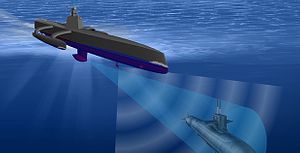The prototype of a U.S. Navy robot ship was recently equipped with a new hull-mounted sonar system, IHS Defense Weekly reports.
The Anti-Submarine Warfare Continuous Trail Unmanned Vessel (ACTUV), received Raytheon’s Modular Scalable Sonar System (MS 3), which “will be integrated as the ACTUV’s primary search-and-detection sonar,” according to the article. The sonar system will produce an “acoustic image” of targets in order to identify and classify vessels in close proximity to the robot ship.
“Designed to autonomously conduct active and passive searches, detect torpedoes, filter passive threats, localize and track submarines, and avoid small objects, the MS 3 is Raytheon’s first fifth-generation medium-frequency hull-mounted sonar system,” IHS Defense Weekly explains.
The ACTUV is an unmanned autonomous trimaran designed by the U.S. Defense Advanced Research Projects Agency (DARPA), an agency responsible for developing emerging technologies for the military’s use. DARPA was tasked with developing an anti-submarine drone — a robot ship capable of tracking enemy subs in shallow waters in 2010.
As I reported before (See: “US Navy to Deploy Robot Ships to Track Chinese and Russian Subs”), the robot ship itself is unarmed and can operate autonomously for 60 to 90 days straight. While deployed the ACTUV surveils large stretches of ocean territory and — should an enemy sub be spotted — guide other U.S. naval assets to the vessel’s location to destroy it.(The ACTUV is in constant contact with other ships or aircraft via satellite link.)
DARPA’s website outlines that the ACTUV’s “objective is to generate a vessel design that exceeds state-of-the art platform performance to provide propulsive overmatch against diesel electric submarines at a fraction of their size and cost.”
Moreover, the ACTUV program is trying to fulfill the following requirements:
Advance unmanned maritime system autonomy to enable independently deploying systems capable of missions spanning thousands of kilometers of range and months of endurance under a sparse remote supervisory control model. This includes autonomous compliance with maritime laws and conventions for safe navigation, autonomous system management for operational reliability, and autonomous interactions with an intelligent adversary.
As I also pointed out previously, autonomous compliance with maritime laws requires the correct identification of surface ships and other objects while at sea. DARPA is in the process of developing non-conventional sensor technologies for that purpose and issued a Request for Information (RFI) back in March 2015.
According to IHS Jane’s Defense Weekly, the construction of the 140-ton ACTUV prototype is about 90 percent complete. It is slated for in-water trials in January or February 2016.

































